Patio cushions are essential for creating a comfortable and inviting outdoor space, adding both style and functionality to furniture. However, one common frustration many face is keeping these cushions in place. Sliding cushions can be caused by various factors, including smooth cushion fabrics that easily shift against furniture, windy conditions, frequent use, or cushions that do not fit properly on the seating surface. These challenges can disrupt the enjoyment of your outdoor area and may lead to constant adjustments or damage over time.

This guide aims to offer practical tips and solutions on how to keep patio cushions from sliding. By addressing the root causes and exploring effective strategies, you can ensure your patio cushions remain secure, regardless of weather or usage. Maintaining a well-organized and comfortable outdoor area becomes simple and stress-free with the right approach.
Choosing the Right Cushions for a Secure Fit
Measuring Your Furniture and Cushions
The first step in preventing sliding cushions is ensuring they fit perfectly on your outdoor furniture. Measure the seating area of your chairs or benches accurately, including width, depth, and height. Then, select cushions that align with these dimensions for a snug fit. Cushions too large can overlap and shift, while undersized cushions may slide around because they lack adequate contact with the furniture surface. A precise fit reduces movement and ensures stability during use.
Selecting Cushions with Non-Slip Features
When shopping for patio cushions, consider designs with non-slip features to improve their grip on furniture. Look for cushions with built-in ties or Velcro straps, as these allow you to secure the cushions directly to the furniture frame. Rubberized backing is another effective option, as it adds friction to prevent slipping. Additionally, cushions made with textured or grippy fabrics are less prone to sliding than smoother materials. By prioritizing these non-slip elements, you can save time and effort spent adjusting cushions while enhancing the overall usability of your outdoor seating area.
How to Keep Patio Cushions from Sliding: Using Cushion Ties and Straps
Step 1: Attaching Built-In Cushion Ties
Cushion ties are one of the simplest and most effective ways to keep your patio cushions in place. Many cushions come equipped with ties that can be looped around chair slats, armrests, or other structural elements of the furniture. Wrap the tie around the chosen area and double-knot it to ensure a secure hold. This method prevents the cushions from sliding and keeps them steady during windy conditions or frequent use. Regularly check the tires for wear and replace them if needed to maintain their functionality.
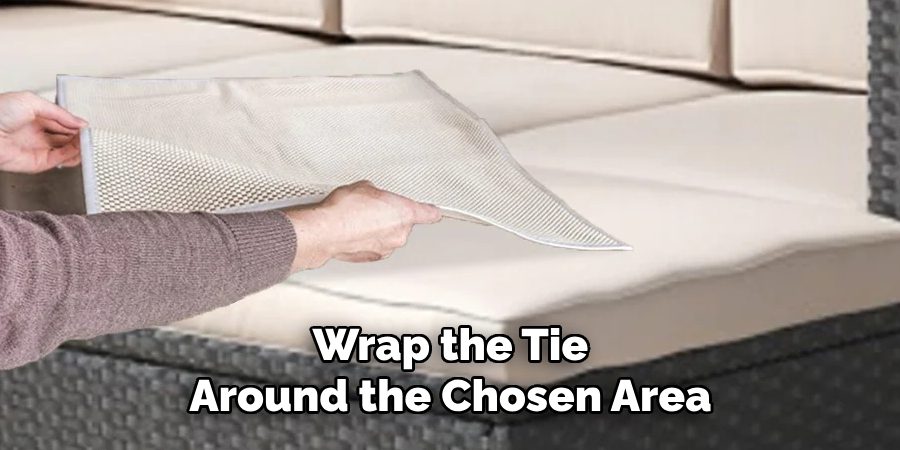
Step 2: Adding Velcro Straps for Custom Solutions
For additional security or when built-in ties are unavailable, adhesive Velcro straps can serve as a customizable solution. Begin by attaching one side of the Velcro strip to the underside of your cushion and the corresponding side to the furniture surface. Make sure the areas are clean and dry before application for optimal adhesion. Once the Velcro is in place, press the cushion firmly onto the seating or backrest to secure it. This approach offers flexibility since you can easily remove and reposition the cushions as needed without sacrificing stability. Incorporating Velcro straps ensures that your outdoor seating remains comfortable, stylish, and hassle-free.
How to Keep Patio Cushions from Sliding: Applying Non-Slip Mats or Grips
Non-slip mats or grips are another effective way to keep outdoor cushions securely in place without requiring permanent attachments. These methods rely on friction to prevent movement and are easy to implement.
Step 1: Using Rubber Shelf Liner or Non-Slip Rug Pads
Rubber shelf liners or non-slip rug pads are an economical and versatile option. Begin by measuring your cushion’s seating area or underside to determine the correct size. Then, cut the non-slip material to fit the space. Place the cut piece between the cushion and the chair surface, ensuring full coverage for maximum grip. The textured surface of these materials creates friction that minimizes sliding during use. This option works especially well for cushions with smooth fabric covers or on slippery chair surfaces like metal or plastic. Additionally, it’s a low-maintenance solution as these liners can be easily removed for cleaning.
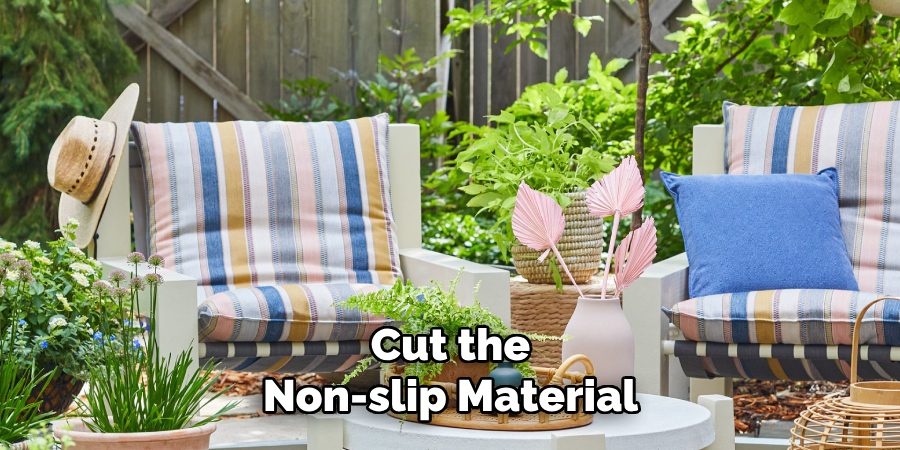
Step 2: Trying Silicone Gripper Pads
For a more durable option, consider using small silicone gripper pads. These pads are designed to temporarily adhere to the cushion and the furniture while providing a strong, non-damaging grip. To use, place the gripper pads at the corners or edges of the cushion, pressing them firmly onto the fabric. Then, position the cushion on the seating surface, ensuring it’s aligned properly. Silicone gripper pads are discreet and weather-resistant, making them ideal for outdoor furniture. They offer additional stability even during repeated use or under windy conditions.
Incorporating non-slip mats or grips into your outdoor seating setup allows you to maintain a neat and functional environment suitable for relaxation or entertaining.
Using Adhesive and Hook-and-Loop Solutions
Step 1: Applying Double-Sided Tape or Sticky Pads
For a quick and temporary solution, outdoor-rated double-sided tape or sticky pads can effectively keep cushions in place. To get started, clean the bottom of the cushion and the seating surface to remove dust or debris that could reduce adhesion.
Cut the double-sided tape into manageable strips and stick them to the four corners of the cushion’s underside. Press the cushion firmly onto the chair or bench to secure it. This method works well when you need a fast fix while ensuring the cushions stay put during use. However, note that this is more suited for short-term applications, as the adhesive may degrade over time when exposed to outdoor weather elements.
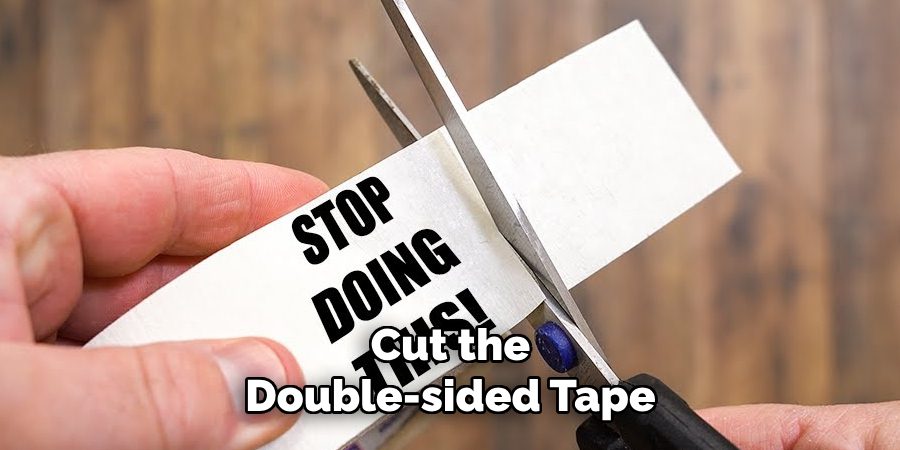
Step 2: Installing Hook-and-Loop Fasteners (Velcro Strips)
For a more versatile and durable option, hook-and-loop fasteners, commonly known as Velcro strips, are ideal. These fasteners are handy if you often need to remove and reposition the cushions. Begin by attaching one side of the Velcro strip to the cushion using the adhesive backing or sewing it on for a stronger hold. Then, secure the complementary Velcro piece onto the furniture surface. Make sure the two sides align properly before pressing them together for a firm grip.
Hook-and-loop fasteners offer flexibility and reliability, making them suitable for outdoor use while maintaining a neat appearance. This solution allows you to enjoy a secure and stable seating arrangement without sacrificing convenience.
Securing Cushions with Bungee Cords or Zip Ties
For situations where stronger and more reliable fastening is required, particularly in windy conditions or for outdoor lounge chairs, bungee cords and zip ties are excellent options. These methods provide a long-lasting hold and ensure your cushions remain secure.
Bungee Cords:
Bungee cords are ideal for furniture with sturdy frames and cushions with built-in loops or straps. To secure the cushions, simply wrap the bungee cords around the furniture frame and thread them through the cushion loops. Tighten the cords until the cushions are firmly held in place but not overly strained. This method ensures a snug fit while allowing for flexibility and movement if needed. Bungee cords are also relatively easy to remove, making this option suitable for those who occasionally rearrange outdoor furniture.
Zip Ties:
Zip ties provide a quick and effective solution for a more permanent fastening. Use zip ties to attach the cushions directly to the furniture frame by threading them through cushion straps or around strategic points on the cushion and furniture. Pull the ties tightly to secure them and trim any excess length for a cleaner look. Zip ties are beneficial in particularly windy environments, as they provide a stable and durable hold. However, removing them will require cutting the ties, making this a better option for long-term setups.
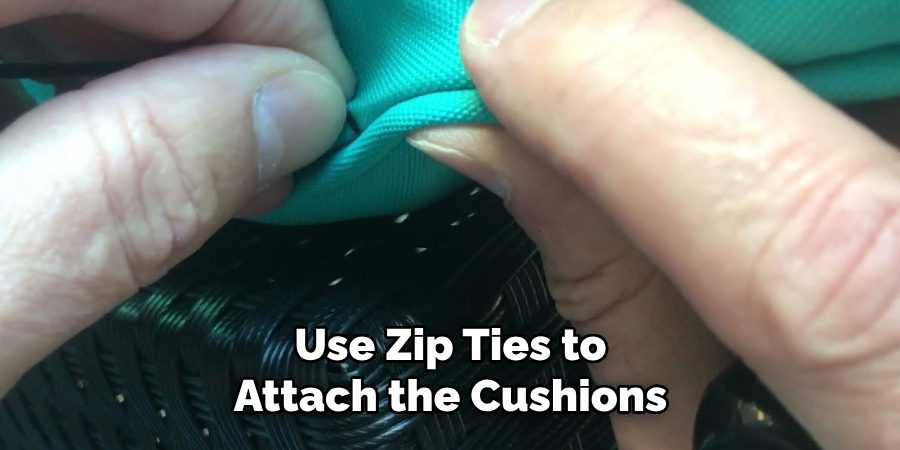
Both bungee cords and zip ties ensure outdoor cushions stay in place, allowing you to enjoy your seating area without the hassle of constantly readjusting.
Alternative DIY Methods to Prevent Sliding
Adding a Rubberized Spray to Cushion Bottoms:
Apply a grip-enhancing rubberized spray to the underside of your outdoor cushions for an easy and effective solution. These sprays create a textured surface that increases friction, helping to keep the cushions firmly in place. Simply follow the spray’s application instructions, allowing adequate time for drying before placing the cushions back on the furniture. This method works well for most cushion materials and does not compromise the overall appearance of your seating area.
Sewing Anti-Slip Fabric to Cushion Bottoms:
A more hands-on and durable approach is to sew a rubberized fabric layer onto each cushion’s bottom. This fabric, commonly used for non-slip rug pads, creates extra grip between the cushion and the furniture surface. Measure and cut the fabric to fit the cushion’s underside, then use strong, weather-resistant thread to stitch it in place securely. This method ensures a long-lasting solution, ideal for cushions that frequently slide out of position.
Using Weighted Cushions or Slipcovers:
Heavier cushions naturally resist sliding better than lightweight ones. Consider using cushions with built-in weights or placing weighted slipcovers over your existing cushions. This approach stabilizes the seating and can be an aesthetic upgrade to your outdoor furniture setup.
Common Mistakes to Avoid
Using Regular Adhesive Tape That Leaves Residue
While adhesive tape might seem like a quick fix to prevent sliding, it often leaves a sticky residue on both the furniture and cushions. This residue can be difficult to clean and may damage the fabric or surface over time. Instead, opt for non-residue adhesives like double-sided carpet tape or specialized non-slip strips.
Over-Tightening Ties, Causing Cushion Damage
Cushion ties are a practical solution, but over-tightening them can lead to fabric tearing or permanent damage to the cushion. Ensure the ties are snug enough to hold the cushion in place without causing undue stress on the material. Regularly check the knots to ensure they are secure but not overly tight.
Choosing Cushions Without Considering Weather Resistance
Outdoor cushions are constantly exposed to elements like rain, sunlight, and humidity. Failing to choose weather-resistant cushions may lead to quick wear and tear, fading, or mold growth. Invest in high-quality cushions made with durable, UV-resistant, and water-repellent fabrics to ensure longevity and ease of maintenance.
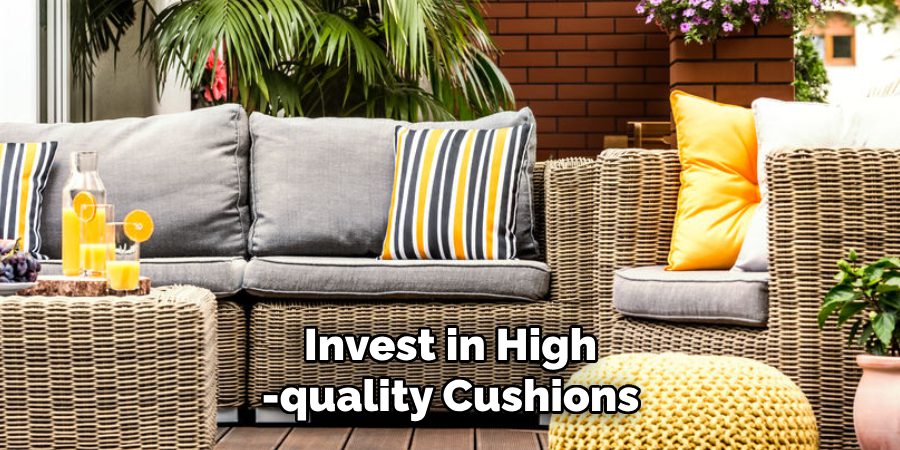
Conclusion
Preventing patio cushions from sliding enhances both comfort and durability in outdoor spaces. You can maintain your outdoor furniture’s appearance and functionality by choosing non-slip solutions such as gripper pads or non-residue adhesives and ensuring cushion ties are properly secured without over-tightening.
Selecting weather-resistant cushions made from durable fabrics is equally important to withstand exposure to the elements. Understanding “how to keep patio cushions from sliding” involves experimenting with different methods based on your specific furniture type and outdoor conditions. With these strategies, you can enjoy a stylish and secure outdoor seating area for years to come.

Professional Focus
Oliver Wood, a passionate patio designer, specializes in creating comfortable and inviting outdoor spaces that enhance relaxation and entertainment. His work combines a deep understanding of design with a love for nature, making him a standout professional in the field of outdoor living spaces. Through his thoughtful approach, he transforms everyday patios into extraordinary retreats for family and friends.
About the Author
Oliver Wood, a skilled patio designer, shares his expertise on outdoor living through his designs and insights. With a background in patio design and a genuine passion for creating beautiful spaces, he encourages others to invest in their outdoor environments, enhancing their homes with functional and inviting spaces for relaxation and entertainment.
Education History
University: Virginia Union University
Oliver’s education equipped him with the knowledge and skills to design patios that merge aesthetics with comfort, transforming outdoor areas into beautiful extensions of the home.
Expertise:
- Patio Design and Outdoor Living Spaces
- Functional and Aesthetic Landscaping
- Comfortable and Inviting Outdoor Environments
- Design Philosophy for Family-Oriented Spaces
- Creating Spaces for Relaxation and Entertainment
